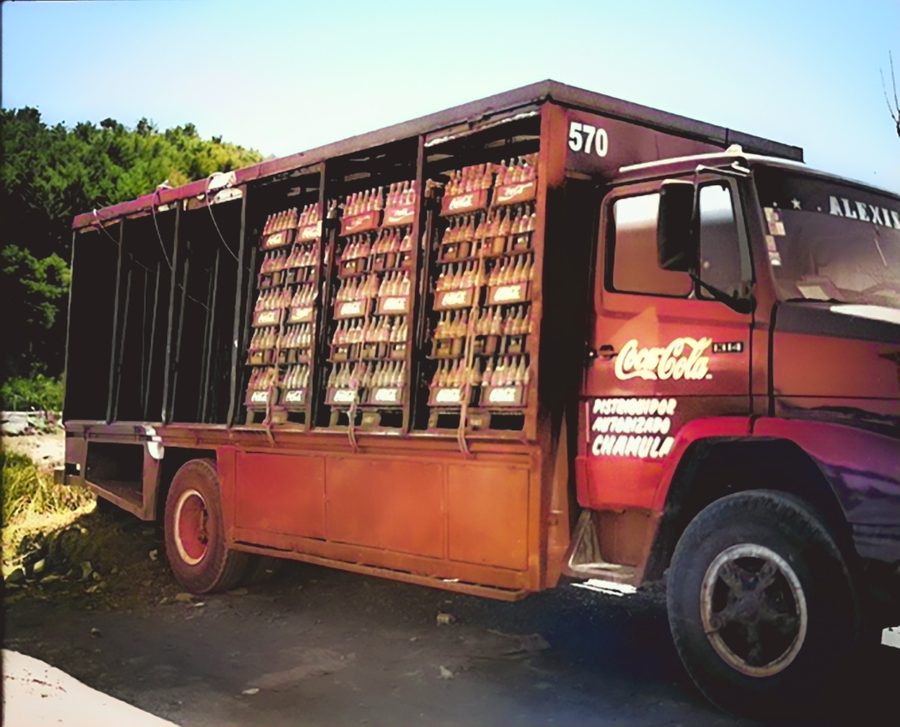Cola Wars in Mexico
Tzotzil Indians in Mexico know the dangers of globalization and soda pop.
Beverly Bell

Thousands of candles flicker in the dim chamber. The air is thick with the smoke from copal incense. On the altar, men in black wool tunics and white knee-length pants play solemn music on drums and gourds. Below them, a score of Tzotzil Indians chant in small circles on the pine needle-covered floor. In the center of each circle are candles, eggs, copal and pox–fermented corn mash – in an old glass container, stopped with a corn cob. And next to the pox is a half-liter bottle of Coca-Cola or Pepsi.
In the 484-year-old Church of St. John the Baptist, in Chamula, a town of 60,000 in Chiapas, Mexico, those bottles indicate the intersection of religion, politics, water and consumer markets.
In the United States, Coke and Pepsi vie for monopoly contracts with schools and universities. In Chiapas, the stakes in the soft drink war are as high as the purity of one’s soul.
Traveling through the cold highlands of the San Juan Chamula municipality any Saturday afternoon, one regularly encounters a scene resembling a battleground: dozens of bodies sprawled on the ground, arms and legs sometimes extending perilously into the road. At the epicenter of each of these scenes are plastic tables and chairs in front of a diminutive wooden store. There, men, women and children who are either on their way to collapse, or who have resuscitated themselves and are back for more, sit drinking pox, which means “mad dog” in Tzotzil. Along with pox, they swig Coke or Pepsi, depending on whose store they patronize; each store sells only one brand.
Like fireworks and copal, pox is a sacrament in a local religion that blends Catholicism with elements of native tradition. It is a sacred drink that cleanses the soul; the more pox one drinks, the greater the purification. Over the past several decades the caciques – local elites who wield economic and political power and control the soft drink concession – have convinced the faithful that pox should be drunk with Coke or Pepsi, depending on who is doing the proselytizing. They say the cola induces burping, which releases evil from the soul.
The caciques and their affiliated drink companies do a booming business – nevermind that the beverages sell for 50 U.S. cents a can, exactly the average daily income. Purchasing a soda often means not purchasing food, and Chiapas has one of the highest rates of both malnutrition and Coke consumption in Mexico.
The drinks also play a political role. A few months before each election, caciques begin providing store owners with all their cola products free of charge. In exchange, each store owner will support his cacique-sponsor’s preferred candidate in the local election, which is invariably a choice between two politicians from the Institutionalized Revolutionary Party (PRI). In turn, the customers of each store get all the cola they want for free, provided they vote for the owner’s candidate. This arrangement helps both the caciques and the PRI to retain their hold on power.
This nexus of politics, religion and commerce is on full display each Sunday in the Chamula town square. The equivalent of the county seat of the 113-community municipality of San Juan Chamula, the town is home to a thriving outdoor market, which sells everything from plastic household items and sides of beef to tourist trinkets. It is also home to the traditional authorities, leaders of the church and the local government. Each week, two or three dozen of them sit in a solemn line in their huaraches, short wool tunics and straw hats with thick fringe of bright ribbons hanging so low as to obscure their faces. Surrounding them are the other pillars of power: the Church of St. John the Baptist, with its candles and cola, the headquarters of the municipal president, and the headquarters of the PRI – the only political party permitted in the town.
The caciques say, “To break with the PRI is to break with tradition.” The tradition is serving them well; the caciques own the Coke and Pepsi warehouses at the edge of town, each containing up to six trucks. Each truck is equipped to carry 180 cases of soda, or 4,320 bottles, out to the village stores.
Sometimes the cola racket can get ugly, as it did in the community of Mitzitón, where the richest and most powerful cacique, José Santíz, controlled both the local PRI governing council and the only store. The Coca-Cola company gave him a refrigerator, chairs, tables and other gifts in exchange for selling a minimum amount of soda each month. Santíz, in turn, forced other members of the council to raise the money to buy eight or nine cases of Coke from him each month; otherwise, he said, he would close the much-needed store. “For us it was very difficult … to be giving money for this devil’s soft drink,” said one council member who requested anonymity. In 2000, some community members organized against the Coke-cacique nexus; in response, thugs burned down one family’s home and threatened others with beatings. About 60 families permanently fled the area.
Coke’s hold on Mexico extends beyond both Chiapas and the PRI. The PRI held a lock on the presidency for 71 years, until finally losing in 2000 to Vicente Fox of the National Action Party, or PAN. Fox’s last job before becoming a politician was serving as president of the Coca-Cola Corporation of Mexico and Latin America. Currently Coke controls 60 percent of the Mexican soda market, while Pepsi has 30 percent.
According to the New York Times, 2006 first-quarter profits for the multinational rose to $1.11 billion, largely due to increased sales in Latin America and China. According to the giant beverage processing company Fomento Económico Mexicano, or FEMSA, each Mexican consumes an average of 483 8-ounce glasses of Coke per year, in a country where more than 12 million citizens do not have access to potable water.
Coke is also widely produced in Mexico, an arrangement that is threatening the country’s water supplies and undercutting indigenous control of natural resources. It takes three cups of water to make one cup of Coke. Since 2000, Coca-Cola has negotiated 27 water concessions from the Mexican government. Nineteen of the concessions are for the extraction of water from aquifers and from 15 different rivers, some of which belong to indigenous peoples. Eight concessions are for the right of Coke to dump its industrial waste into public waters. To aid the extractive and dumping processes, Fox – with help from the World Bank – has successfully pursued water privatization, as well as a massive land privatization program, that allowed companies free access to all the resources on the land, including water.
After Fox’s victory, Coca-Cola began bottling water from the richest aquifer in the Chiapan town of San Cristóbal de las Casas, an ecological reserve administered by a conservation group Pronatura, which receives money from Coca-Cola Mexico. In 2004, the Coke plant in San Cristóbal de las Casas used 107,332,391 liters of water – about as much as 200,000 homes.
In 2003, following the international call sent out by many groups and networks at the World Social Forum, organizations in Chiapas launched a boycott against Coca-Cola. They cited corporate domination, the assassination of unionized workers at a Coke plant in Colombia, labor rights violations and toxic leakages as reasons for the boycott. But the primary demand for the boycotters is an end to Coke’s growing domination of the nation’s water, especially on indigenous territories.
Chiapas being the locus of the world’s first revolution against neoliberalism, boycott initiators had expected that that revolution’s proponents would be strong constituents. In fact, the Zapatistas continue to be heavy consumers of Coca-Cola overall, though some autonomous communities have taken on the campaign. Subcomandante Marcos himself is a Coca-Cola drinker, claims Eduardo Sánchez, an exasperated Zapatista boycott organizer. Still, Sánchez is unable to hide his grin as he repeats what Marcos is reported to have said: “We have a way to get rid of Coke. We will drink every last bottle.”
Nevertheless, the boycott is growing steadily in Chiapas and, to a lesser degree, throughout Mexico. Down the road past Chamula one sees, for the first time in miles, something other than ads for Coke or Pepsi – a painted sign advertising Mexican product Big Cola which is not connected to caciques, the PRI or religious ritual. Two years ago, the storeowner’s son convinced his father to switch from Coke. Representatives of Coca-Cola showed up at the shop and told the owner that Big Cola was making people sick. The Coke reps also told the owner that if he would give them his three Big Cola trucks, they would give him five Coca-Cola trucks in exchange. Big Cola remains.
Some communities have banished Coke. In Xoxocotla, an indigenous village in the southern state of Morelos, after the company told shop owners that they would have to stop selling other soft drinks if they wanted to keep purchasing Coke, residents held an assembly in the plaza and decided to kick the corporation and its products out of their village.
Surveying the caciques as they sit in front of St. John the Baptist Church one Sunday afternoon, Gustavo Castro Soto, a Chiapas-based intellectual author of the boycott, says, “Consciousness about the role of Coca-Cola relates to the economy, society, politics, culture and even the military. It has to do with human rights, labor rights, rights of indigenous peoples, and control of lands and water by the multinational. This consciousness will grow and integrate citizens, communities, and universities into a giant boycott. It all starts with our consumption habits.”





